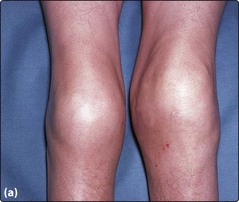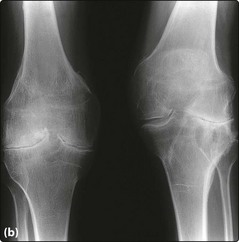36 As factor VIII is a critical component of the blood coagulation pathway (see p. 12), low levels predispose to recurrent bleeding. The likelihood of bleeding can be roughly predicted from the factor VIII level, which may be expressed as units/dL or as percentage activity (Table 36.1). Table 36.1 Factor VIII level and clinical severity of haemophilia The disease usually becomes apparent when the child begins to crawl. Severely affected patients not receiving prophylactic treatment experience 30–50 bleeding episodes each year. The most common problems are spontaneous bleeds into joints, often elbows or knees, although any joint can be involved. Patients may develop particular target joints which bleed frequently. They often have an innate feeling that a bleed has started prior to any objective signs. Recurrent or inadequately managed joint bleeds lead to chronic deformity of the joint with swelling and pain (Fig 36.1). Fig 36.1 Chronic knee damage in severe haemophilia A. Bleeding may also afflict deep-seated muscles, often the flexor muscle groups. If ignored, the enlarging haematoma can compress adjacent nerves and vessels with serious consequences (Fig 36.2). Haematuria is not unusual and, until recently, intracranial bleeding was the most common cause of death in haemophilia.
Haemophilia
Haemophilia A
Clinical features
Factor VIII level
Clinical severity
Less than 2 units/dL
Severe: frequent spontaneous bleeds into joints and muscles
2–5 units/dL
Moderate: some spontaneous bleeds, bleeding after minor trauma
5–45 units/dL
Mild: bleeding only after significant trauma or surgery
Bleeding in haemophilia


(b) Shows bilateral osteoporosis, narrowing of the joint space and joint deformity.
![]()
Stay updated, free articles. Join our Telegram channel

Full access? Get Clinical Tree


Haemophilia

